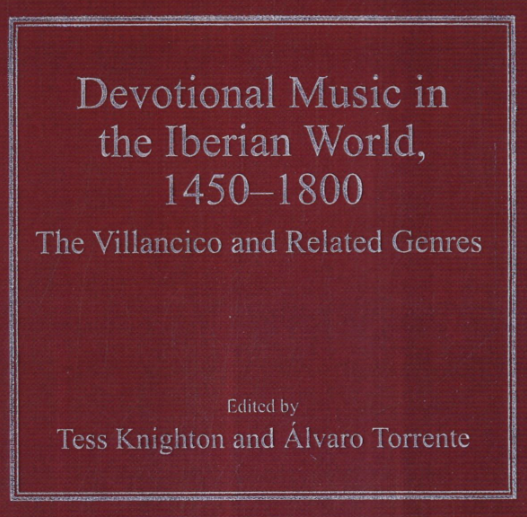
イベリア世界の宗教音楽、1450年~1800年:ヴィリャンシーコとその関連ジャンル
Devotional music in the Iberian world,
1450-1800 : the villancico and related genres

☆ 15世紀から19世紀初頭にかけて、信心のための音楽はイベリア世界において重要な役割を果たしていた。通常「ヴィリャンシーコ」という総称で呼ばれる土 地言葉の歌は、マドリガル、エンサラダ(エ ンサラーダ)、トノ[Tono humano (secular song)]、カンタータ(Cantata)、 さらにはオラトリオなど、さまざまな形式を含んでいたが、それらは主要な教会、王立および私設 礼拝堂、修道院、修道院などで定期的に催される多くの宗教的祝祭で演奏されていた。これらの作品は、他の国々でラテン語のモテットが担っていた役割を徐々 に果たすか、補うようになった。また、祝祭ごとに新たに作曲されることが多かったため、現存する資料はラテン語の作品よりもはるかに多く、その数は数万に 上る。世俗のジャンル、音楽、文学、パフォーマティビティとの密接な関係により、これらの作品はイベリア世界全体に現地のスタイルを広める主要な手段と なった。この音楽制作のモデルはポルトガルでも発展し、スペインとポルトガルのアメリカやアジアの植民地に急速に輸出された。多くの場合、ヴィリャンシー コのレパートリーは、これらの地域で制作された音楽の現存する最古の資料であり、国民的アイデンティティの形成において重要な役割を果たしている。本書に 収録された16編の論文は、この時代におけるイベリア世界の宗教音楽の発展を探究し、この重要なジャンルの初めての包括的な調査を提供している。
Devotional music in the
Iberian world, 1450-1800 : the villancico and related genres
/ edited by Tess Knighton, Álvaro Torrente, Ashgate , 2007
| From
the fifteenth century to the beginning of the nineteenth century,
devotional music played a fundamental role in the Iberian world. Songs
in the vernacular, usually referred to by the generic name of
'villancico', but including forms as varied as madrigals, ensaladas,
tonos, cantatas or even oratorios, were regularly performed at many
religious feasts in major churches, royal and private chapels, convents
and in monasteries. These compositions appear to have progressively
fulfilled or supplemented the role occupied by the Latin motet in other
countries and, as they were often composed anew for each celebration,
the surviving sources vastly outnumber those of Latin compositions;
they can be counted in tens of thousands. The close relationship with
secular genres, both musical, literary and performative, turned these
compositions into a major vehicle for dissemination of vernacular
styles throughout the Iberian world. This model of musical production
was also cultivated in Portugal and rapidly exported to the Spanish and
Portuguese colonies in America and Asia. In many cases, the villancico
repertory represents the oldest surviving source of music produced in
these regions, thus affording it a primary role in the construction of
national identities. The sixteen essays in this volume explore the
development of devotional music in the Iberian world in this period,
providing the first broad-based survey of this important genre. |
15
世紀から19世紀初頭にかけて、信心のための音楽はイベリア世界において重要な役割を果たしていた。通常「ヴィリャンシーコ」という総称で呼ばれる土地言
葉の歌は、マドリガル、エンサラダ(エ
ンサラーダ)、トノ[Tono humano (secular
song)]、カンタータ(Cantata)、
さらにはオラトリオなど、さまざまな形式を含んでいたが、それらは主要な教会、王立および私設礼拝
堂、修道院、修道院などで定期的に催される多くの宗教的祝祭で演奏されていた。これらの作品は、他の国々でラテン語のモテットが担っていた役割を徐々に果
たすか、補うようになった。また、祝祭ごとに新たに作曲されることが多かったため、現存する資料はラテン語の作品よりもはるかに多く、その数は数万に上
る。世俗のジャンル、音楽、文学、パフォーマティビティとの密接な関係により、これらの作品はイベリア世界全体に現地のスタイルを広める主要な手段となっ
た。この音楽制作のモデルはポルトガルでも発展し、スペインとポルトガルのアメリカやアジアの植民地に急速に輸出された。多くの場合、ヴィリャンシーコの
レパートリーは、これらの地域で制作された音楽の現存する最古の資料であり、国民的アイデンティティの形成において重要な役割を果たしている。本書に収録
された16編の論文は、この時代におけるイベリア世界の宗教音楽の発展を探究し、この重要なジャンルの初めての包括的な調査を提供している。 |
| https://ci.nii.ac.jp/ncid/BA83939777 |
|
| Contents: Preface Introduction, Tess Knighton and A lvaro Torrente Waving ensaladas, Pepe Rey Song migrations: the case of AdorA!moste, SeA+/-or, Tess Knighton The villancico in the works of early Castilian playwrights (with a note on the function and performance of the musical parts), Alberto del RA o Function and liturgical context of the villancico in Salamanca Cathedral, A lvaro Torrente 'The third villancico was a motet': the villancico and related genres, Andrea Bombi The villancico as music of state in 17th-century Spain, Pablo-L. RodrA guez Religiosity, power and aspects of social representation in the villancicos of the Portuguese Royal Chapel, Rui Cabral Lopes 'Music charms the senses...': devotional music in the Triunfos festivos of San Gines, Madrid, 1656, Janet Hathaway A literary and typological study of the late 17th-century villancico, Alain Begue Pastorelas and the pastoral tradition in 18th-century Spanish villancicos, Pilar Ramos LA(3)pez The noA"l A grand chA"ur of south-western France and the Iberian villancico: towards a comparison, BenoA (R)t Michel De rosas cercada: music by Francisco de la Huerta for the nuns of Santa Ana de A vila (1767-78), MarA a Gembero UstA!rroz Historical and literary vestiges of the villancico in the early modern Philippines, David Irving The 'ethnic villancico' and racial politics in 17th-century Mexico, Geoffrey Baker The popular, the sacred, the colonial and the local: the performance of identities in the villancicos from Sucre (Bolivia), Bernardo Illari Bibliography Index. |
目次:序文 序文、テス・ナイトンとアルバロ・トルエンテ サラダを振る、ペペ・レイ 歌の移動:AdorA!mosteのケース、SeA+/-or、テス・ナイトン 初期カスティーリャの劇作家によるヴィリャンシーコ作品(音楽パートの機能と演奏に関する注釈付き)、アルベルト・デル・ラオ サラマンカ大聖堂におけるヴィリャンシーコの機能と典礼上の背景、アルバロ・トルエンテ 「第3のヴィリャンシーコはモテットであった」:ヴィリャンシーコと関連ジャンル、アンドレア・ボンビ 17世紀スペインにおける国家の音楽としてのヴィリャンシーコ、パブロ・L・ロドリゲス ポルトガル王立礼拝堂のヴィリャンシーコにおける宗教性、権力、社会的表現の側面、ルイ・カブラル・ロペス 「音楽は感覚を魅了する...」:1656年マドリッドのサン・ヒネス祭のトリウンフォにおける信心の音楽、ジャネット・ハサウェイ 17世紀後期ヴィリャンシーコの文学的・類型論的研究、アラン・ベグ 18世紀スペインのヴィリャンシーコにおけるパストレーラスと牧歌的伝統、ピラール・ラモス・ラ・ 南西フランス地方のグランド・シャール楽派のノアールとイベリアのヴィリャンシーコ:比較に向けて、ベノア・ロート・ミシェル 修道女たちのためのフランシスコ・デ・ラ・ウエルタ作曲の音楽:ア・ビラのサンタ・アナ修道院(1767-78年)、マリア・ゲンベロ・ウスタルロス 近現代フィリピンにおけるヴィリャンシーコの歴史的・文学的痕跡、デイヴィッド・アーヴィング 17世紀メキシコにおける「民族ヴィリャンシーコ」と人種政治、ジェフリー・ベイカー 大衆、神聖、植民地、そしてローカル:スクレ(ボリビア)のヴィリャンシーコにおけるアイデンティティのパフォーマンス、ベルナルド・イラーリ 参考文献 索引 |
| https://ci.nii.ac.jp/ncid/BA83939777 | |
| A cantata (/kænˈtɑːtə/;
Italian: [kanˈtaːta]; literally "sung", past participle feminine
singular of the Italian verb cantare, "to sing") is a vocal composition
with an instrumental accompaniment, typically in several movements,
often involving a choir. The meaning of the term changed over time, from the simple single-voice madrigal of the early 17th century, to the multi-voice "cantata da camera" and the "cantata da chiesa" of the later part of that century, from the more substantial dramatic forms of the 18th century to the usually sacred-texted 19th-century cantata, which was effectively a type of short oratorio.[1] Cantatas for use in the liturgy of church services are called church cantata or sacred cantatas; other cantatas can be indicated as secular cantatas. Several cantatas were, and still are, written for special occasions, such as Christmas cantatas. Christoph Graupner, Georg Philipp Telemann and Johann Sebastian Bach composed cycles of church cantatas for the occasions of the liturgical year. |
カンタータ(/kænˈtɑːtə/;イタリア語:
[kanˈtaːta];文字通り「歌われた」、イタリア語動詞「cantare」(歌う)の過去分詞女性形単数形)は、楽器の伴奏を伴う声楽作品で、通
常は複数の楽章からなり、しばしば合唱団が参加する。 この用語の意味は時代とともに変化し、17世紀初頭の単純な単声のマドリガルから、同世紀後半の多声の「カンタータ・ダ・カマーラ」や「カンタータ・ダ・ キエーザ」、18世紀のより大規模な劇的な形式、そして19世紀の通常は聖典に基づくカンタータへと発展した。後者は実質的に短いオラトリオの一種であっ た。[1] 教会礼拝の典礼で使用されるカンタータは、教会カンタータまたは聖カンタータと呼ばれます。その他のカンタータは世俗カンタータと区別されます。クリスマ ス・カンタータなど、特別な機会向けに作曲されたカンタータも数多く存在し、現在も作曲されています。クリストフ・グラウプナー、ゲオルク・フィリップ・ テレマン、ヨハン・セバスティアン・バッハは、典礼年の行事向けに教会カンタータのサイクルを作曲しました。 |
| https://en.wikipedia.org/wiki/Cantata |
|
| With
the westward extension of Spanish imperial endeavours in the 16th
centmy,
the villancico was introduced to the Philippine Islands together with a
large variety
of sacred and secular musical forms. This paraliturgical genre would
eventually
take root at the very crossroads of social and racial structures in the
colony, finding
continual favour amongst the successive waves of immigrants from Spain
and
Latin America, whilst also being appropriated by the local
population-whose preconquest practices included comparative
verse-refrain genres-and in many cases
being absorbed into indigenous oral traditions. In these respects, the
villancico
represented the multifaceted nature of many Iberian genres in the
colonial milieu.
It was, on one hand, an explicit symbol of cultural universality in the
empire, as
poetic texts that were popular throughout the Hispanic world could be
set to music
by various composers in different localities-the fame of works by the
Musa
Americana, Sor Juana Ines de la Cruz, for example, spread not only
throughout the
Americas and to peninsular Spain, but also across the Pacific to the
Philippines. 1
On the other hand, the prevalence of the villancico in civic
festivities and in the
celebratory acts of religious and lay organizations also provided
opportunities for
local poets and chapelmasters to engage in demonstrations of their
creative skills,
whilst indigenous musicians and actors in the metropoles and provinces
brought
elements of theatricality into the ecclesiastical functions of the
missions and parishes. |
16
世紀、スペインの帝国主義が西へ拡大するにつれて、ヴィリャンシーコは、さまざまな宗教的および世俗的な音楽形式とともにフィリピン諸島にも伝わった。こ
の典礼音楽以外のジャンルは、植民地の社会構造と人種構造の交差点で徐々に定着し、スペインやラテンアメリカから次々とやってくる移民たちに愛され続け、
征服前に比較詩のジャンルを歌っていた地元住民にも受け入れられ、多くの場合、先住民の口承の伝統に吸収された。こうした点から、ヴィリャンシーコは植民
地社会におけるイベリア半島のさまざまなジャンルの多面性を体現していたといえるだろう。一方では、ヒスパニック世界全体で人気のある詩的なテキストは、
さまざまな地域のさまざまな作曲家によって作曲されることで、帝国の文化の普遍性を明確に象徴するものとなった。例えば、ムサ・アメリカーナ[=アメリカの音楽]、ソル・フア
ナ・イネス・デ・ラ・クルスの作品は、南北アメリカ大陸やスペイン半島だけでなく、太平洋を越えてフィリピンにも広まった。一方、市民のお祭りや宗教団体
や世俗団体の祝賀行事においてヴィリャンシーコが広く普及したことで、地元の詩人や礼拝堂長たちがその創造力を発揮する機会も生まれ、大都市や地方に住む
先住民出身の音楽家や俳優たちが、宣教活動や教区での宗教儀式に演劇的要素を取り入れた。 |
リ ンク
文 献
そ の他の情報
**
Copyleft, CC, Mitzub'ixi Quq Chi'j, 1996-2099
☆
 ☆
☆